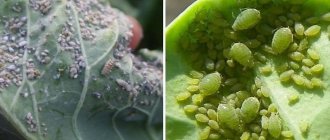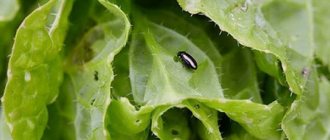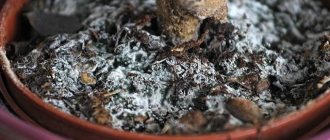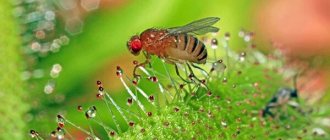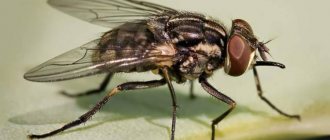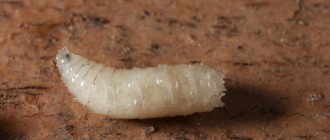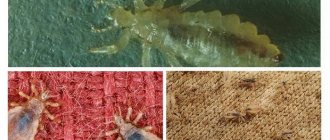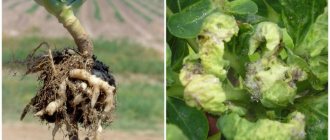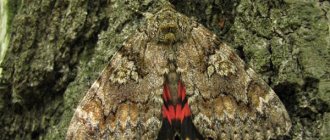Aphids are a dangerous parasite from the order of hemipteran insects that feed on the sap of young plants. This pest often settles on the lower part of cabbage leaves, sucks out the vital juices from them, leading to various diseases and even death of the plant. To prevent such consequences, it is necessary to recognize aphids on cabbage leaves in time and take all measures to combat them.
How to recognize aphids?
Aphids are an invisible but dangerous insect that feeds on plant sap. It can be recognized by the following external characteristics:
- the body is translucent, egg-shaped and short in length - about 2.2-2.5 mm;
- the color of the body is pale green, often appearing gray due to a waxy coating, with brown transverse torn stripes that begin from the first element of the abdomen;
- the head is brown with black eyes and short antennae consisting of 5-6 segments;
- the oral apparatus is small and designed like a proboscis, piercing the integumentary tissues of leaves and drawing out juice from them;
- the tail is conical, dark green in color and without marginal tubercles;
- the legs are brown, as are the cylindrical tubes, which are slightly swollen in the middle and slightly shorter than the tail.
Such pests can often be found on representatives of cruciferous plants, which include not only all types of cabbage, but also the following crops:
- daikon;
- turnip;
- radish;
- radish.
The pest reproduces quickly, since the birth of offspring occurs without fertilization, and one female can lay up to 40-50 larvae. Moreover, about 15-20 generations of this pest change during the season.
In spring and summer, only female insects are born. Males are born in the fall, when females lay eggs on cabbage heads or other cruciferous plants left over for the winter. They winter well if the plants are under snow. In the spring, when the air temperature reaches +11-12°C, the larvae hatch from the eggs, and their life cycle repeats. Females without wings appear after several lines, after about half a month. They do not need males for fertilization, and each of them is capable of producing up to half a hundred larvae.
Know how to care for cabbage after planting in open ground
| Where to plant It is necessary to choose the correct landing place. The bed should be in the sun for 80% of the daytime. It is necessary to plant in open ground when the daytime temperature stabilizes at 18 ºC | |
| How to water Only planted seedlings need to be watered daily. Approximately 0.5 liters per bush. For grown cabbage, increase watering. On average, at least 2 liters of water should be spent per bush. Water cabbage with heads that are setting, generously, 4 liters of water per plant. Watering should be done in the morning or evening. Pour water around the edges of the hole. Watering should be reduced 2 weeks before harvesting the heads of cabbage. | |
| When to loosen and hill up 5 days after planting, carry out the first loosening. Do it after watering. Loosen the second time after 2 weeks. The depth should be at least 12 cm. With the appearance of the first new leaves after replanting, loosen the soil under the crop and immediately hill it up. This refers to the raising of soil towards the stem. Hill up only on damp soil. Do the next hilling in 12 days | |
When to fertilize
| |
| How to protect against diseases and pests 1. Diseases To prevent fungal diseases, disinfect the soil before planting seedlings with a strong solution of potassium permanganate or copper sulfate. Conduct regular inspection of crops and remove leaves with signs of disease. 2. Pests Among the pests of cabbage are:
The above compositions of traditional methods can be used to eliminate insects and their metabolic products. Among chemicals, the insecticide “Iskra” will help against most pests. To destroy slugs, various traps and molluscicides are used, for example, “Predator”, “Ulicid”, “Slug Eater” |
Causes of aphids
In most cases, aphids appear on plants after females accidentally fly into the garden in the spring and lay eggs in the weeds, from which many larvae hatch after winter. This will be the beginning of the insect’s reproduction mechanism.
In addition, ants can spread aphids. They coexist very closely with this pest, since aphids secrete tasty food for them - sweet-tasting honeydew. Thus, ants keep aphid eggs in their anthills even in winter, and in the spring they take them out to the site and spread them over young plants.
If cabbage is infested with aphids, many black ants can often be found on it or near the plantings.
About the pest
There are many types of aphids: carrot, melon, root, mealy, legume, etc. Cabbage is exclusively affected by the cabbage aphid.
Aphids on cabbage are quite common. The pest is a small (up to 2mm) greenish-yellow insect. It prefers to live on young plants, feeding on their juice using a long proboscis. As a result, the leaf plates take on the appearance of a dry shell. The insect is very dangerous for the plant because it carries more than 20 different infections of garden crops.
Aphids on cabbage
Good weather conditions contribute to the spread of pests. From the eggs laid in the fall, larvae hatch in the spring and turn into wingless females. They feed on cruciferous weeds before switching to young cabbage plants. At this time, aphids are most numerous, as they reproduce without fertilization. Each such individual is capable of giving birth to 4 dozen larvae, which prefer to live on the back side of cabbage leaves. As a result, the latter become depleted, begin to dry out and die completely.
In July, winged females appear and migrate throughout the land area. In the fall, winged males hatch. After mating, fertilized females lay eggs on cabbage stalks for wintering.
Important!
The short life cycle of the aphid compensates for its fecundity: during the warm season, up to two dozen generations can change. Therefore, every gardener needs to know how to treat cabbage against aphids.
Signs of cabbage damage
Aphids reproduce very quickly, so the sooner they are detected, the better. This can be done by regularly inspecting the cabbage leaves. If the pest has already attacked the cabbage, then this will be indicated by the following signs:
- the leaves become discolored, especially at the top, fade and become more fragile;
- the area between the veins on the leaf blades seems to be decaying and gradually begins to dry out;
- the plant gradually loses its green color, becomes covered with yellow spots and dries out, as it loses chlorophyll and becomes unable to fully carry out photosynthesis;
- cabbage grows poorly because it absorbs nutrients extremely slowly and at the same time quickly loses its vital juices;
- a sticky dirty coating appears on the plant, which is a waste product of parasites;
- with severe damage, the leaves curl into tubes and become deformed, and heads of cabbage do not form.
When inspecting cabbage for the presence of aphids, you need to take into account that the pest initially multiplies on the lower part of the bushes, and over time it spreads to the entire plant.
With severe damage, accumulations of aphids can be seen even with a superficial examination of the cabbage.
Why are aphids dangerous?
The danger of aphids for cabbage lies in the fact that it multiplies quickly, sucks the vital juices from the crop and provokes disruptions in its vital functions, which is why the vegetable develops poorly and dies.
In addition, aphids can infect the plant with various fungal and viral diseases, including:
- mosaic;
- black ring spot;
- necrotic jaundice, etc.
The fact is that aphids are capable of transmitting various diseases from diseased plants to healthy ones. So, if there is a diseased plant in the garden, colonies of insects will quickly spread pathogenic microflora, so other garden plants growing in the neighborhood will also suffer.
Resistant varieties
The constant work of breeders to create new varieties that are resistant to pests, including aphids, has borne fruit. Below are some varieties that are characterized by increased resistance to attacks by aphids and other insects.
Aggressor
A variety of late-ripening white cabbage, Aggressor, was developed in the Netherlands, which fully justifies its name. It is productive, resists frost well, but its main advantage is that harmful insects, including aphids, are not at all interested in it.
Amager 611
This late cabbage variety has been cultivated for a long time and has received a huge number of positive reviews from gardeners. Preference is given to it because it is relatively resistant to a number of diseases and a certain list of pests. In addition, Amager 611 is high-yielding, and its heads of cabbage are well stored.
Bartolo
This is another high-quality, high-yielding late variety developed in the Netherlands. Plants of this variety rarely become infected with clubroot or fusarium. Bartolo is less often attacked by pests than other varieties.
Snow White
This variety of cabbage is late in maturity, with flat heads that can be stored for more than six months. Aphids are not interested in this variety, so they rarely attack it.
Why is it difficult to control aphids?
Getting rid of aphids is not so easy, since predatory insects refuse to peck them. The fact is that when absorbing cabbage juices, aphids accumulate glucosinolate in the body, and a fermented substance, myrosinase, appears in its muscles. When a predator attacks an aphid, it begins to secrete these enzymes, which are converted into mustard oil - a real poison for birds. As a result, the predators either die or escape.
Even ladybugs that prey on aphids either die after a while due to mustard oil or crawl away from the colonies.
Meanwhile, the aphidius larva copes with aphids. It lives in the insect's body, causing it to swell into a ball, turn brown, stick to the leaf and die. It is known that the breeding of such larvae is carried out in special laboratories, so ordinary gardeners often do not have access to them. However, there are other ways to combat cabbage pests, which can be found below.
Advantages and disadvantages of using folk remedies
The war against aphids using traditional methods undoubtedly has advantages:
- safety. Perhaps this is the most important point, especially for those gardeners who have animals or small children. Folk control measures are not toxic and do not harm beneficial insects, soil or the plant itself;
- simplicity. It is more than simple to prepare a mixture to combat aphids yourself; you just need to follow the instructions and advice;
- cheapness. Traditional therapy products do not require special expenses and are sold in any store.
See also
The best way to feed cabbage for growth using folk remedies, when and how to apply fertilizer
Read
Despite the positive aspects, traditional methods of killing parasites still have several disadvantages:
- duration of treatment. Compared to chemicals, safe products take longer to kill the parasite;
- not resistant to moisture. Mixtures and infusions are easily washed off by rain or dew, but this can be corrected by adding soap.
Methods for controlling aphids
After discovering aphids in your garden plot, you must immediately begin to combat them. In this case, it is advisable to immediately apply several methods, each of which will be considered separately.
Biological and mechanical methods
It is proposed to breed birds and insects on the site, which can destroy this pest before it turns into an adult insect.
For these purposes, you need to attract the following birds to the cabbage patch:
- tits;
- warbler;
- linnets;
- Vorobyov.
To do this, you need to install special feeders filled with grain crops:
- sunflower seeds;
- millet;
- millet;
- oats
Tits will also be happy with hung unsalted lard, hard-boiled eggs, and grained cottage cheese.
Among insects, it is better to attract those individuals that are able to cope with aphid larvae. These include:
- Ladybugs . They can be attracted by installing log houses with holes for wintering on the site. This method is relevant for southern areas where winters are warm. In other regions, to attract ladybugs in the garden, it is better to plant the following plants: yarrow;
- tansy;
- buckwheat;
- dill;
- angelica;
- sweet clover
In order to repel aphids, you can also plant spicy plants on the site, in particular:
- basil;
- mint;
- garlic;
- onion;
- fennel;
- lavender.
Some experienced gardeners sow tobacco between the beds, as it destroys cabbage caterpillars and aphids.
These methods are acceptable in the early stages of cabbage infestation by aphids, when it is still in the form of a larva. In case of a large pest invasion, they are ineffective, so they will have to be combined with the use of chemicals.
Physical way
Acceptable at the stage when there are still few pests in the garden. In this case there is no need to use chemicals. The method is to destroy aphids with your own hands. To do this, the beds must be carefully inspected, and any identified pests must be crushed directly on the cabbage.
Chemical method
The most reliable and effective method of combating aphids, which involves treating cabbage with biologically active preparations and chemical insecticides. Popular means include:
- Pyrethrum . Biological preparation in powder form based on chamomile. Before processing, it must be diluted in water at the rate of 60 g per 10 liters of liquid. Spray cabbage with it in calm weather once every 2 weeks throughout the vegetable growing season.
- Karbofos . A toxic but very effective broad-spectrum remedy that helps get rid of adult pests and larvae. The insecticide must be diluted in water at the rate of 7.5 g per 5 liters. When spraying plants, wear equipment (respirator, rubber gloves). The weather should be dry, without gusty winds. Use the drug 1 time. After treating cabbage, the parasites will die within 2 hours, and the protective effect will last for 20 days or more, depending on weather conditions.
- Seifos . Not as poisonous as Karbofos. It is more often used in cases where the seedlings were not treated before planting in a permanent place. The plant should be sprayed with a solution of 5 g of product per 5 liters of water. After spraying, the aphids disappear within 2-3 days.
- Spark . The insecticide is sold in several variations, so its packaging may have the prefix “Gold”, “Bio” or “Double effect”. Available in powder, tablet or liquid form. Before use, the drug must be diluted in water according to the instructions on the package. After treatment, plant protection lasts about 3 weeks. To consolidate the effect, it can be re-applied after 15 days, and then once a month throughout the growing season. The last treatment should be carried out at least 20 days before harvest.
- Deltamethrin . A broad-spectrum insecticidal drug that can immediately destroy pests, since it blocks the transmission of nerve impulses in them, which leads to their paralysis and death. It is harmless to humans, as it contains only natural ingredients. It begins to act immediately after processing the cabbage and over the next 20 days.
Other drugs based on deltamethrin are also produced, including Decis pro, Fas and Atom.
To prevent aphids from getting used to chemicals, they need to be changed annually. Although their use allows you to quickly get rid of pests, they still pose a danger to the vegetable, so after processing the cabbage should be fed with natural fertilizers.
There are products that simultaneously destroy aphids and feed cabbage. You can learn about one of them from the video below:
Traditional methods
Not all gardeners like chemical treatment of plants. Many people prefer to use folk remedies that do not have a toxic effect. These include:
- Water supplied under pressure . You can get rid of aphids using water supplied through a hose. This creates pressure, causing insects to be washed off the plants. The aphids can no longer crawl back. If you shower frequently, you can gradually get rid of these insects.
- Soap solution . Prepared from laundry or tar soap. For 10 liters of water you need to take 100 g of soap. Spray the heads and legs with the prepared mixture from a spray bottle.
- A mixture of soap and soda . Dilute 1 tbsp in 10 liters. l. soda ash and 1/2 bar of laundry soap, grated on a fine grater. Spray the mixture onto the cabbage.
If you use only soda, it will not linger on the leaves and will quickly be washed away by rain, so it is supplemented with soap.
- Infusion of ash . For a 10-liter bucket of water, take 2 cups of wood ash. Mix the mixture thoroughly and apply it to the cabbage leaves. The ash can also be used in combination with cinnamon and pepper (red and black). Spices need to be mixed in equal proportions and add 200 g of wood ash. Separately, dilute 200 g of laundry soap in 1 liter of warm water, add the finished powder and 9 liters of cool water. Mix the composition thoroughly and use as directed 2 times with intervals of 3 days. For preventative purposes, cabbage can be processed once a month.
- Tobacco decoction . To prepare a concentrated product, you need to grind 10 g of dry tobacco, add 5 liters of water and leave for 24 hours. Next, boil the composition for 2 hours over low heat, after adding another 5 liters of water. Treat cabbage with broth from a watering can or spray bottle.
- Orange peel decoction . Take 2 cups of crushed and dried orange peels, pour warm water over them and leave for 24 hours. Then boil the composition for about 10-15 minutes, strain and dilute with 10 liters of water. At the end, add 100 g of soap and use as directed.
- Spicy infusion . Prepare garlic, horseradish (leaves or roots) and hot pepper. Grind the horseradish, fill the pan a third with it and pour boiling water over it. Leave until the water cools down. Take 2 pods of hot pepper and a head of garlic, finely chop and pour 1 liter of boiled water. Then pour this solution into the pan with horseradish. Before treating plants, add a little liquid soap.
- Infusion of celandine . Take 4 kg of raw or 1 kg of dry herb, pour 10 liters of hot water and leave for 24 hours. Strain the composition, add a little liquid soap and use as intended.
- Infusion of potato or tomato tops . Finely chop fresh tomato or potato tops. You can take both in equal parts. Fill the pan halfway with the prepared raw materials and pour in boiled water. Leave for 24 hours, strain and add a little soap. Treat cabbage with the prepared mixture.
- Sorrel infusion . Aphids do not like the sour infusion of horse sorrel. To prepare it, dig up the roots of the plant, chop it and pour boiling water at the rate of 150 g per 5 liters of water. Leave for 24 hours and use to spray affected plants.
- Dandelion infusion . Dig up dandelion roots (200 g) and collect leaves (500 g). Grind the raw materials and leave for about 3 hours in boiling water. Strain the mixture, add liquid soap and treat the cabbage with it.
- Chamomile infusion . To prepare it, take 100 g of dry raw materials, pour 1 liter of boiling water and leave for 12 hours. Strain the infusion, pour in 2 liters of water, add a little soap and spray the plants with it.
- Infusion of onion peels and onions . Take 2 onions and some onion peels. Chop the onion, combine with the peel and add 2 liters of hot water. Leave for about 4 hours, add soap and use as directed.
- Infusion of pine needles . Prepared within 1 week. Take 1 kg of pine needles and pour 4 liters of boiled water. Leave for a week, stirring the needle daily. Before using the infusion, dilute it with water in equal proportions.
- Vinegar . Repels insects with its pungent odor. You need to take 1 tbsp. l. essences and dilute in 10 liters of water. It is enough to treat cabbage with the product 2 times to completely get rid of aphids.
- Mustard . To treat affected leaves, you can prepare a solution of 50 g of powder per 5 liters of water. In addition, dry mustard should be scattered near anthills, because ants are distributors of aphids.
- Essential oils . In the fight against aphids on cabbage, the use of essential oils - tea tree, lavender, thyme, cedar - shows excellent results. 10 drops of each product should be diluted in 0.5 liters of water and sprayed with the composition on each cabbage leaf. Processing should be done in the evening.
- Ammonia . Like vinegar, it repels insects with its pungent reserve. Helps get rid of even adult aphids. In 10 liters of water you need to stir 50 ml of ammonia and pour the cabbage from a watering can.
You can use an alcohol solution no more than once every 14 days, otherwise excess nitrogen will lead to deformation of the leaves and impaired growth of the vegetable.
How to treat cabbage with an effective folk remedy based on ammonia is described in the video below:
Preventive measures
Preventive methods include interspersing cabbage bushes with garden crops that repel aphids. These include: fennel, carrots, lettuce, onions, chamomile. By planting cabbage between rows, you can protect the plant from pests. You also need to observe crop rotation. Having planted cruciferous crops twice on one plot, you can expect an aphid attack next year.
The best predecessors: garlic, legumes, carrots. After harvesting the cabbage, you need to dig up and get rid of the above-ground parts where insects lay “overwintering” larvae. The soil needs to be dug up and fertilizing added.
Rules of care and timely processing
There is no need to wait until aphids attack cabbage; you can protect the future harvest by preventative spraying of the garden before planting. Special agents are used that act on insects through the soil or directly on them. Before transplanting, young seedlings are also processed.
Once the plant has taken root, it can be sprayed with a mild insecticide. Treatment can be carried out when the first ovaries appear. It is not recommended to poison cabbage with chemicals after flowering; this may negatively affect the harvest in the future.
Attention: It is prohibited to use insecticides near water bodies, since many products have a negative effect on fish. They should not be used near apiaries: bees may die during active use. https://www.youtube.com/embed/RoKqkH9DvHM
Selection of resistant varieties
Breeders have developed different varieties of cabbage that are highly resistant to aphids:
- Amager is a late-ripening hybrid, characterized by frost resistance, high yield, preservation, and is resistant to cabbage aphids.
- Aggressor is a late variety, easy to grow, can grow in any conditions, and is resistant to pest attack.
- Snow White is a late hybrid with flattened heads of cabbage, stored for up to 6 months. The variety is versatile to grow; its main advantage is resistance to aphids.
- Bartolo is a late-ripening variety, has a high yield, and is resistant to many diseases and pests, in particular to aphids.
Getting rid of cabbage aphids using traditional methods is more difficult than spraying the bushes with chemicals. You need to prepare the composition and use it several times to get the desired effect. But this control method has an important advantage: it is safe and will not make the crop environmentally harmful.
Previous CabbageProcessing and protecting cabbage from slugs and snails Next CabbageWhy and what to do if cabbage has purple leaves
Prevention
There are a number of preventive measures that will help protect your garden from aphids:
- in late autumn, completely clear the area from the remains of vegetable crops, dry them and burn them, and do not keep them in the garden;
- in the fall, carefully dig up the soil to a depth of at least 25 cm;
- fight weeds in a timely manner, removing them from all paths;
- use mixed planting technology, planting herbs and tobacco near the cabbage bed;
- follow the rules of crop rotation, planting cabbage after carrots, onions and legumes;
- pay special attention to fertilizing cabbage, since aphids appear on weak young plants that are not fertilized enough.
Mistakes of inexperienced gardeners
The most common mistakes that can lead to the spread of aphids are:
- Violation of landing rules . If you do not maintain the optimal distance between plants, apply fertilizers at the wrong time and improperly water the seedlings, the plants will turn out weakened and will attract the attention of insects.
- Chemical abuse . They destroy not only aphids, but also insects that prey on them. It turns out that such treatment harms the plants. It is necessary to use chemicals only when there are too many aphids and they can completely destroy the entire crop.
- Preservation of aphid eggs . Many gardeners do not remove stalks and weeds in the fall, so the eggs laid on them remain overwintering in the garden bed, and the larvae hatch in the spring.
Aphids are small-looking insects that can destroy large cabbage crops. It is important to start combating the pest in a timely manner, and even better, to prevent its appearance by observing preventive measures. It is also important to follow agricultural techniques for growing and caring for cabbage.
0
0
Copy link
Useful tips
To grow cabbage in open ground, you need to follow the recommendations from experienced gardeners:
- Water the seedlings with warm water, then the seedlings will be stronger and more resistant to disease.
- It is necessary to feed and pick early cabbage. Seedlings need to be grown at a temperature of 18 degrees during the day and 8 degrees at night. Fertilizing is done after the first 2 leaves appear. Gardeners advise using Zdraven. The next feeding is carried out after 10 days. A liter of mullein is diluted in water and the seedlings are watered.
- To make the vegetable crop resistant to diseases, hardening is carried out. Once a week, water the seedlings with a solution of potassium permanganate. 3 g are diluted in 10 liters of water.
- Before planting cabbage, hardening begins 10 days before planting. Periodic hardening is carried out. Such seedlings will be able to withstand frosts down to -7 degrees.
- It is worth planting seedlings in a sunny area. It must be protected from draft and wind.
- It is better to plant early varieties of cabbage in a place where onions, cucumbers or turnips used to grow, and late-ripening varieties in an area where there was a good potato harvest.
- Before planting seedlings, dig up the soil well; it should be loose. Organic matter or mineral fertilizers are first added to the soil.
- A certain distance must be maintained between the rows: for late varieties - 80 cm, and for early varieties - 45 cm.
- Before planting, add 2 glasses of warm water to each hole, then the root system will not experience a moisture deficiency.
- After planting, the soil is sprinkled with dry soil, and late varieties are planted directly into the soil.
To get a high yield of cabbage, you need to know the rules for planting seedlings and provide regular care for the vegetable crop. You need to water the vegetable properly and constantly monitor its development and growth. If aphids appear on the leaves, then all plants must be treated. First you should try folk remedies, if they don’t help, then start using chemicals. The main thing is to choose the right pest control product.
